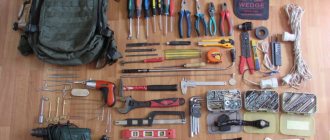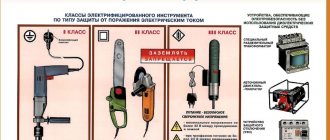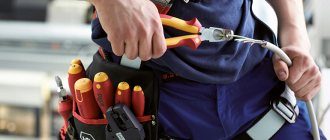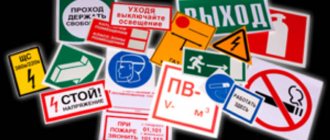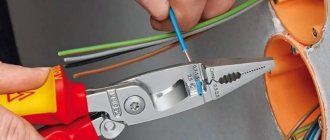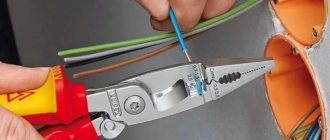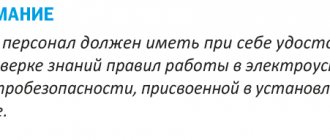Who can be an electrician?
Only a person who has reached the age of majority, with specialized training and a diploma can work as an electrician. In addition, the specialist must have a certificate indicating the electrician’s approval group.
When a person comes to work with electricity, he does not always imagine what kind of risk to life the profession promises. What could be dangerous? Here's what:
- Electric shock when servicing electrical installations and electrical equipment.
- Increased noise level when working in the workshop.
- Falling from height.
- Gas pollution and dust in production areas.
- Work outdoors in any weather, temperature changes in the workshop.
To train personnel in safety precautions, warning posters and electrical safety stands are hung on the walls of the enterprise, and instructions are given.
When the lecture is given, each electrician signs the safety briefing log. Thus, a person takes responsibility for his life and health. If something happens, the installer himself will be to blame.
As you can see, working as an electrician requires increased attention, responsibility and is associated with constant stress.
Occupational health and safety requirements before starting work.
2.1. Wear clean and serviceable overalls, safety shoes and other personal protective equipment required by regulations. Before each use of tools and protective equipment, be sure to check their serviceability, the absence of external damage, contamination, and check the expiration date on the stamp. It is prohibited to use protective equipment that has expired.
2.2. Make sure that your hands, clothes and shoes are always dry; Remember that the work involves electric current.
2.3. Put your workwear in order: fasten the cuffs of the sleeves; Wear a tight-fitting headdress and tuck your hair under it.
2.3.1 Safety glasses must be the right size, the glass must not fall out, have cracks, chips, scratches and be clean with good visibility. By tensioning the headband, ensure that the glasses fit snugly to your face.
2.3.2 Use a protective helmet when working in rooms with power equipment: in closed switchgear and open switchgear, in wells, tunnels and trenches and when repairing and servicing overhead lines. The protective helmet should not have cracks, dents from impacts, and the internal equipment of the helmet should not be damaged. The helmet must be worn with a chin strap adjusted to fit.
2.3.3. Inspect dielectric gloves, paying attention to the absence of
mechanical damage, contamination and moisture, as well as punctures by twisting the gloves towards the fingers.
2.3.4. Inspect dielectric galoshes in order to detect possible
defects (detachment of facing parts or lining, presence of foreign hard inclusions).
2.3.5. Inspect tools (screwdrivers, pliers, pliers, wire cutters),
insulating coatings should not have defects that lead to a deterioration in appearance and a decrease in mechanical and electrical strength.
Work in existing electrical installations should be carried out according to the order, order or list of works performed in the order of current operation.
2.4.1. It is prohibited to carry out work without authorization, as well as to expand jobs and the scope of the task determined by the work order or order. It should be remembered that after the voltage in the electrical installation disappears, it can be reapplied without warning.
2.4.2. Small-scale types of work performed during a work shift, and permitted for production in the order of routine operation, are contained in the “List of work performed in the order of routine operation,” approved by the plant director.
In this case, the following requirements must be met:
2.4.2.1. work in the order of current operation (list of works) applies only to electrical installations with voltages up to 1000 V;
2.4.2.2. the work is performed by operational or operational-repair personnel on the equipment or area assigned to these personnel. Preparation of the workplace is carried out by the same employees who subsequently perform the necessary work.
2.4.3. Any other work not specified in the List is prohibited without issuing an order or work order.
2.5. Immediately before starting work, carry out technical measures to ensure the safety of work in electrical installations in the following order:
2.5.1. Disconnect the electrical installation.
2.5.2. Hang up a prohibitory sign: “Do not turn on, people are working” or “Do not turn on, work on the line.”
2.5.3. Check the absence of voltage using a working and tested voltage indicator.
2.5.4. Turn on the grounding blades (Z.N.), install a portable grounding (P.G.) or make a visible break.
2.5.5. If necessary, fence off the workplace and post instructive posters.
2.6. Before starting work, receive targeted instruction on labor protection and safety when working according to an order or order from your immediate supervisor and sign the order or in the Journal for issuing orders and orders.
Preparatory work
You can’t just come in and start repairing an electrical installation or equipment. There are several points that an electrician must complete before proceeding.
- Wear protective clothing that will protect against electric shock.
- Receive an assignment from your boss. A mechanic can act according to the direction of his boss, but he cannot take the initiative himself.
- Check the lighting in the workplace. It is very important that the work area is well lit; the electrician must take care of this himself.
- Prepare all equipment and tools for work. It’s much more convenient when everything is at hand and you don’t have to look through your pockets and suitcases.
Primary requirements
The list of electrician safety precautions begins with perhaps the most important one—voltage relief. In order to properly de-energize the work area, you need to see a diagram of the area where installation or reconstruction is being carried out. In addition to the diagram, it is important to understand the location of the switching devices (which are needed for disconnection) and the power source of a particular area. First of all, it is necessary to exclude the possibility of turning on the machine or switch.
To do this, the electrician's safety instructions include the following instructions:
- A poster or sign must be posted on the switch handle indicating that the handle must not be touched.
- The same sign is located on the door of the panel or room where the device is located.
- It is necessary to disconnect the wires from the switching parts.
In order for the work to be organized correctly, you need to appoint a responsible person who will monitor compliance with safety regulations. It may not be possible to foresee everything in advance, because there is a human factor, but something can be corrected during the work process.
Safety measures during operation and repair of electrical equipment
Inspections of electrical installations. Electrical installations are inspected without removing voltage from them, away from live parts. Defects are detected visually - by inspection and by ear. The right to single-handedly inspect an electrical installation is granted to an attendant with a qualification group of at least III or an administrative and technical employee who has group V in installations with voltages above 1,000 V and group IV in electrical installations with voltages below 1,000 V.
GENERAL SAFETY REQUIREMENTS.
Most of the work is done at height. To prevent falls from a height, it is necessary to use safety devices.
When performing work in electrical installations, serviceable and tested protective equipment must be used. The working crew must be fenced off by signalmen as directed by the work manager. In cases where work is carried out with voltage relief, it must be remembered that in areas electrified with alternating current, life-threatening voltage induced from the suspensions of neighboring tracks arises in the wires of the contact network and overhead lines. Only on a disconnected and grounded line can you work without the use of insulating agents.
Persons at least 18 years of age who have undergone a medical examination, industrial training in safe labor methods, passed exams in the qualification commission and have a certificate of knowledge testing in electrical safety are allowed to work in electrical installations.
When at work, an electrician is required to carry a knowledge test certificate with a warning coupon and present it upon request by workers monitoring compliance with safety requirements.
A warning coupon may be confiscated from an employee by administrative and technical personnel for violating safety requirements. After the withdrawal of a warning coupon, the employee’s knowledge is tested for the issuance of another coupon within two weeks to the extent of the violated sections of this Instruction.
The electrician must be provided with special clothing, special footwear, as well as serviceable, tested protective and installation equipment, and signaling accessories in accordance with established standards.
Responsible for safety when performing work are:
an employee issuing a work order or giving orders to carry out work;
ECC duty officer, issuing an order to carry out work;
responsible work manager;
work producer;
watching;
brigade members.
The work manager supervises the workers and is responsible for the safety of team members during the work process. All technological operations, including movements of team members at the work site, must be carried out only on his command.
The supervisor is responsible for the safety of workers and their compliance with the requirements of instructions for the safe performance of work. When appointed as a supervisor, an electrician is required to maintain constant supervision over the assigned workers, requiring them to implement safety measures.
Each team member is responsible for compliance with these Instructions and local instructions, as well as instructions received during briefing. He must take the necessary measures if he notices a violation committed by other members of the team. During the work process, the team member must follow the instructions of the work manager or supervisor.
Dangerous places, as well as signs, permanent and temporary signal signs, hand signals used on the contact network, are given in the appendix. 3 and 4 to the Instructions.
WORK AT HEIGHT.
Work at height is considered to be all work performed with a rise from ground level to the worker’s feet to a height of 1 m or more. These works can be classified into different categories depending on the specific conditions.
It is forbidden to climb onto a wooden support without checking it for rotting.
Before climbing onto supports, supporting structures and wires, the electrician must visually check their good condition, as well as the presence of grounding. The spark gap or diode grounding switch must first be short-circuited with a shunt jumper with a copper cross-section of at least 50 mm2.
Lifting should be carried out from the field side of the support, and if there are overhead wires and overhead lines on the support, from the sides.
The work should be carried out using a safety belt. It is necessary to attach the carabiner or lanyard of the safety belt to the support, crossbar, cables, wires and other securely fastened structures. In this case, it should be attached in such a way that it is impossible for the worker to approach electrically hazardous elements, even in the event of a fall, at a distance less than that established by the category of work. When securing the full length of the sling with a carabiner, the attachment point should be no lower than the level of the worker’s chest.
During instructions and during work, the work supervisor must indicate in advance to the electrician where the carabiner or safety belt lanyard is to be attached.
You can unfasten the carabiner to attach it to a new place only when there is reliable support at three points, i.e. for two legs and an arm.
It is forbidden to remove the safety belt before completely descending to the ground.
Work should be done in carefully tucked clothes. The soles of shoes must provide reliable grip (not slip) when moving along structures and steps of stairs.
It is prohibited to work simultaneously in several tiers along the same vertical, as well as to be on the ground directly under those working.
Persons who, in case of production necessity, have to be briefly directly under someone working at height, must exercise special caution.
When installing a contact line support, installing consoles or brackets, electricians are prohibited from standing under an unsecured structure, suspended on pulley blocks, or under a moveable structure.
Do not throw tools or materials to anyone working above. They should be served by climbing a ladder or using a rope.
It is allowed to move up and down devices, parts and structures weighing up to 25 kg using a “fishing rod”, and over 25 kg - with a pulley hoist. To prevent the load being lifted from swinging, the worker below must pull it back with the free end of the rope.
It is prohibited to attach ropes intended for lifting loads directly to someone working at height.
To climb onto the support, special “claws”, manholes, and ladders can be used. Before lifting, using “claws” or manholes, you should securely fasten them to your legs and use a sling from the safety belt to cover the support post. The sling should be moved along the support in compliance with the requirements of clause 6.5 of the Instructions.
When working, the “claws” or manholes must be installed so that they are loaded evenly. If manholes or “claws” are the only means of climbing to a support, then the team should have at least two sets of them.
The team must have at least two safety belts.
Fire safety
To maintain fire safety, each enterprise must implement a set of mandatory organizational measures, namely:
determine the responsibilities of officials to ensure fire safety;
have all the necessary types of technical fire protection equipment and other protective equipment available
appoint those responsible for fire safety of individual buildings, structures, premises, areas, technological and engineering equipment, as well as for the maintenance and operation of technical fire protection equipment;
introduce an appropriate fire safety regime;
prepare, approve and familiarize all employees with:
· – general facility instructions on fire safety measures;
· – relevant instructions for all explosion- and fire-hazardous premises;
draw up plans (schemes) for evacuation of people in case of fire;
approve the procedure (system) for notifying people about a fire, familiarize all employees with it;
determine the categories of buildings and premises according to explosion and fire hazards in accordance with the requirements of current regulatory documents, as well as determine the classes of zones according to the “Rules for the Construction of Electrical Installations”;
install appropriate fire safety signs on the territory, in buildings and premises, signs indicating the telephone number and the procedure for calling the fire department.
Particular attention is paid to special measures to prevent fires from the thermal manifestations of electric current.
Internal documents establishing the fire safety regime at the enterprise are developed by those responsible for fire safety and approved by the head of the enterprise. Documents are stored in a special folder on fire safety issues.
The documents should indicate, in particular, the following:
rules for using electric heating household appliances, using open fire, performing temporary fire hazardous work;
smoking area;
the procedure for inspecting and closing premises upon completion of work;
procedure for servicing technical fire protection equipment (fire extinguishers, fire alarm systems, automatic fire extinguishing systems, smoke absorbers, self-rescuers and other fire protection equipment);
responsible persons who must conduct special training and instructions to personnel on fire safety issues, and the frequency of these activities;
actions to be taken by employees in the event of a fire
. The list of documents may be different for each enterprise. The main documents required by the fire authorities are given below:
Order(s) on the appointment of those responsible for fire safety of individual buildings, structures, premises and extensions;
An order (corresponding provision) on the procedure according to which special training and instructions should be provided to employees, and their knowledge on fire safety issues should be tested;
Program for conducting introductory fire safety training;
Program for conducting initial fire safety training;
A list of questions on which knowledge should be tested after initial, repeated and unscheduled fire safety briefings;
Logbook for registration of briefings on fire safety issues;
Expert opinion (expert opinions) regarding the correctness and completeness of the implementation of fire safety requirements in the design and estimate documentation for construction, reconstruction, technical re-equipment of production and other facilities, introduction of new technologies;
Permission(s) for the start of operation of each newly created enterprise, the commissioning of new and reconstructed facilities, for the introduction of new technologies, the launch into production of new fire-hazardous machines, equipment and products, for the rental of any premises, buildings and structures;
Certificate(s) of conformity for all types of fire fighting equipment and equipment;
List of responsibilities of officials to ensure fire safety;
Orders, instructions establishing the appropriate fire safety regime;
General facility instructions on fire safety measures;
Instructions on fire safety measures for all explosive and fire hazardous premises (areas, workshops, warehouses, workshops, laboratories and others);
Plans (schemes) for evacuation of people in case of fire;
Instructions for security workers (security guards, watchmen, guards, duty officers);
A list of company officials compiled specifically for security workers, in which (the list) the home address, business and home telephone numbers of each of these persons should be indicated;
Schedules and reports of measurements of insulation resistance of electrical networks and electrical equipment;
Documentation, the list of which is given in the “Rules for the technical maintenance of fire automatic installations”;
Regulations for the maintenance of fire automatic systems, fire warning systems, fire extinguishers;
Schedules and reports for checking the resistance of grounding devices;
Work permits for performing hot work.
The fire safety folder should also contain documents about voluntary fire brigades, fire technical commissions, and the operation of fire automatic systems (if the enterprise has them).
We draw your attention to two items from the above list - instructions and evacuation plans; such documents should usually be posted in a visible place.
Each enterprise must have general (for all facilities) instructions and instructions for all explosion- and fire-hazardous premises (areas, workshops, warehouses, workshops, laboratories, etc.). All employees of the enterprise must familiarize themselves with these documents during fire safety briefings, fire-technical “minimum”, and industrial training. Instructions must be posted in prominent places throughout the facility. Each instruction must be recorded in the appropriate journal.
If the enterprise is located in a two-story building or higher, if more than 25 people are in it at the same time, then you must hang plans (schemes) for evacuation of people in case of fire in visible places.
The employee who prepared the evacuation plan must sign it, and the head of the enterprise must approve it with the fire authorities.
All company employees must undergo fire safety training. Each fire safety briefing, except for the targeted one (before temporary fire work), must be recorded in a special log.
The procedure for special training, instruction and testing of knowledge of enterprise employees is determined by order of the head of the enterprise, based on the recommendations of the fire inspection staff that you have chosen.
All buildings, production and warehouse premises, as well as laboratories, must be divided into categories of explosion and fire hazard, and also be divided geographically into zones by class in accordance with the Electrical Installation Rules.
The designation of the category and class of the zone is indicated on the entrance doors to the premises, as well as on the boundaries of the zones - indoors and outdoors.
In addition, inside the building, in prominent places near telephones, signs indicating the telephone number of the fire department are placed.
Special signs must indicate where fire extinguishers are installed. Such signs are attached in visible places at a height of 2.0–2.5 m from the floor inside and outside the premises. Important to remember:
A necessary condition for meeting the requirements of fire safety standards and regulations is the installation of fire safety signs in rooms, buildings, and structures that comply with GOST. Such signs should warn employees of possible danger and provide the necessary information about actions in the event of a fire.
On the territory of those facilities where smoking is permitted, the administration must identify and equip a special place for smoking. An appropriate sign or inscription is installed there, as well as a trash can or ashtray made of non-combustible materials.
However, please remember that some facilities are non-smoking. These include:
facilities (their territory and premises) for the extraction, processing and storage of flammable substances, combustible materials and flammable gases, for the production of explosives;
buildings containing explosion- and fire-hazardous premises (areas), commercial enterprises, warehouses and bases;
premises of preschool, school and medical institutions;
grain and cereal arrays and grain collection points.
CONCLUSION
The topic of this thesis is the electrical equipment of a specialized screw-cutting lathe with increased model accuracy (your machine). During the work, the following issues were considered:
— purpose and design of the machine;
— maintenance of electrical equipment;
— repair of electrical equipment components;
— grounding of electrical equipment.
A calculation and selection of wires and fuse links was carried out. The operating principle of the electrical circuit diagram of the machine is described in detail. Attention is paid to occupational health and safety. The topic of this thesis is relevant, since this machine is widely used in production.
Emergency procedures
If the electrician’s safety precautions were violated and a person was electrocuted, then the entire team must provide first aid. What are we talking about?
- The victim must be freed from exposure to electricity.
- The victim must be checked for consciousness, pulse, and breathing. This will help doctors assess the person’s condition.
- Contact an ambulance as quickly as possible.
- If there is no pulse or breathing, then resuscitation measures must be started as soon as possible to restore signs of vitality.
Rules for work
No random person will be allowed to work with electricity. Each installer must have an electrician's license. To get it, you need to graduate from a secondary or higher educational institution, only after that you are allowed to start working.
What should electricians know? The fact that complete safety is achieved only by de-energizing the room. If you simply turn off the light, only one network will be de-energized, but the other wires will carry current.
To be sure to eliminate a threat to life, you need to find the distribution panel and unscrew the fuses on it, and then press the circuit break button. If the shield is linear, then simply lower the lever.
To ensure that the room is de-energized, the electrician must use an indicator screwdriver or power indicator. When the indicator lights up, current is still flowing. In such cases, you need to check how correctly the shutdown was performed. If everything is fine, then you can begin work, while notifying all persons who have access to the shield.
Labor protection and safety requirements during work.
3.1. Be attentive to the performance of work (do not be distracted by extraneous matters and conversations, do not distract others). In case of accidents, in order to free the victim from the effects of electric current, the voltage must be removed immediately, without the prior permission of the work manager.
3.2. Work only with tools that meet the following requirements: insulating handles must be made in the form of covers or in the form of a non-removable coating made of moisture-resistant, oil- and petrol-resistant, non-fragile electrical insulating material with stops on the side of the working body, with the test period not expired. Insulating handles both on the surface and in the thickness of the insulation should not have holes, chips, swelling, or defects; the insulation must cover the entire handle, its length must be at least 100 mm to the middle of the stop. The working part of the screwdriver must be well sharpened. The insulation of the screwdriver shaft should end no more than 10 mm from the end of the screwdriver blade.
3.3. Immediately before using the voltage indicator, it is necessary to check its serviceability by approaching live parts located nearby and known to be energized.
3.5. When working on scaffolding, make sure that it is in good condition, has the appropriate load capacity and is marked with a permissible load. The scaffolding flooring must be dense and firmly fixed. The scaffolding must have side boards and handrails secured from the inside. Do not throw anything down or leave loose tools and parts on the scaffolding.
3.6. Maintenance of lighting installations located on the ceiling of machine rooms and workshops of the plant should be carried out from special platforms of overhead cranes or from a trailed suspension bridge by at least two workers, one of whom has a safety group of at least III, the second worker must be close to the worker and monitor compliance with the necessary safety measures. The trolley wires must be de-energized before being lifted onto the trolley. When working, you should use a safety belt.
3.7. When working at height in existing electrical installations, safety belts should be used.
3. 8. Installation and removal of fuses, as a rule, is carried out with the voltage removed. Under voltage, but without load, it is permissible to remove and install fuses at connections containing switching devices. Under voltage and under load, it is allowed to remove and install fuses of voltage transformers and plug-type fuses in electrical installations up to 1000 V. When removing and installing fuses under voltage, you must use:
3.8.1. in installations with voltages over 1000 V - insulating pliers (rod), dielectric gloves and safety glasses;
3.8.2. in installations with voltages up to 1000 V - insulating pliers or dielectric gloves, and in the presence of open fuses and safety glasses.
3.8. Do not work near moving drive belts, shafts, gears, etc., unless they are guarded.
3.9. Do not remove covers or guards from equipment while it is in operation.
3.10. Before starting up temporarily disconnected equipment, at the request of the workshop personnel, the electrician is obliged to inspect it, make sure it is ready to supply voltage and warn the personnel working on it about the upcoming switching on.
3.11. Do not put on drive belts when starting electric motors; put them on by turning the motor pulley manually, making sure that the equipment is disconnected from the power supply.
3.12. Before starting the electric motor, check its fastenings.
3.13. When turning on transformers, pay attention to the labels at the terminals (220, 36, 12 V).
3.14. When dismantling and lifting the electric motor, do not grasp the coupling half mounted on the shaft, as it may turn and cause injury.
3.15. When carrying out work in high-risk and particularly dangerous areas, use portable electric lamps with a voltage of no higher than 50 V. When working in particularly unfavorable conditions and in outdoor installations, you should use portable lamps with a voltage of no higher than 12 V.
3.16. When unwinding the cable from the drum, be careful not to put your feet under the drum.
Dielectric tool
To avoid a threat to life, it is important to use the right tools, which include a dielectric tool set. What it is? This is the name for instruments with dielectric handles. If they are marked 1000 Volts, then using the equipment you can service electrical networks.
Attention! When a cable or wire is found to be damaged, it must be replaced. Under no circumstances should you repair the damaged area, as this is fraught with subsequent breakdowns.
All activities related to the maintenance of grounding elements, fuses, distribution boards are carried out only by people who have an electrician’s license. Moreover, even electricians are not allowed to work without the appropriate permits and documents.
Safety at home
Safety instructions for an electrician include not only network maintenance, but also connecting new devices. This is due to the fact that improperly connected household or other equipment can cause a short circuit or simply cause an electric shock.
So, according to GOST standards, the following points must be observed:
- Carefully study the new device before connecting it to the network or carrying out repairs.
- Use metal clips for good fixation.
- Do not connect or use several devices at the same time that consume a lot of energy.
- Do not touch plugged in devices with wet hands or other parts of your body. This is especially true when touching someone in the shower or bathtub.
- If sparking is noticed, you must immediately unplug the device from the outlet.
- Do not pull the cord out of the outlet by the plug.
- Before you start working, you need to remove all jewelry and metal products.
It is especially important not to leave children alone with electrical devices and not to repair them in front of children.
Safety regulations in industrial production
Compliance with safety precautions at industrial facilities when working with electricity is an integral part of the entire production process. In case of non-compliance with these norms and rules, the administration of the enterprise may impose penalties in the form of deprivation of monetary remuneration or the imposition of a fine. If accidents occur, those responsible may be subject to administrative or criminal liability. That is why, when working with electricity, employees must strictly follow safety regulations:
- Persons with theoretical and practical knowledge and skills who have received documentary evidence of this in the form of education diplomas are allowed to work with electric current;
- Persons who have been trained and certified in safety precautions are allowed to work with electric current, which must be confirmed by an appropriate certificate and an entry in the safety log indicating the name, position and date of the instruction and passing the exam. Everything must be confirmed by the personal signature of the employee being examined;
Logbook for registration of safety briefings when working with electric current
- All employees are certified, regardless of position. Team leaders who do not have direct contact with electric current during the production process bear full responsibility for their subordinates performing the work;
- It is forbidden to start work without wearing a special protective uniform;
- Electrical equipment must be grounded and suitable for the work being performed;
- It is prohibited to use electric tools in places with a high degree of fire and explosive areas that do not have the appropriate protection class;
- The use of faulty electrical equipment is prohibited;
- It is prohibited for strangers to be in the danger zone during work;
- When working in a damp environment (indoors or outdoors), it is permitted to use a tool with the appropriate protection class, which must be confirmed by a certain sticker on the device body:
- Protection class 1 is intended for work in safe rooms;
- Tool protection class 2 can be used both indoors and outdoors in areas with increased danger;
- The 3rd protection class allows the equipment to be used in particularly dangerous places.
- Before starting the work process, the integrity of electrical devices, wires, adapters and sockets is inspected: for the presence of grounding cables, absence of damage to the housing. Idle operation is checked. Only after this is power supplied to the installation;
- When changing nozzles and spare parts of equipment, before starting the process, the entire installation must be de-energized;
- When working with particularly powerful mobile electrical installations, the use of specialized wires with the necessary flexibility and degree of protection from mechanical stress, grounding and RCD is required.
Entry from the magazine on safety precautions when working with electric current
Compliance with safety precautions when working with electric current plays a huge role, both in the industrial sphere and in the life processes of every person, regardless of age range, because not only health, but life depends on it. Therefore, an equally important factor is the knowledge of the correct operation of electrical equipment and the ability to provide first aid if necessary.
Particular attention is paid to this issue in large enterprises, where annual seminars are held with practical and theoretical tasks for employees on the subject of first aid, as well as consideration of behavior in the event of critical situations at work.
Providing first aid to the victim
An equally important factor is compliance with safety standards in everyday life when operating household appliances. Compliance with basic rules can eliminate the occurrence of dangerous situations, preserving the life and health of a person and the people around him at a critical moment.
Safety rules for on-duty mechanics
It is customary to leave electricians on duty. In this case, the installer must also follow certain rules, namely:
- Monitor the working condition of the protective grounding or grounding.
- Do not connect wires to metal equipment and structures.
- Do not allow electricians to repair equipment or wiring themselves.
- Carry out insulation work efficiently, because if you leave a bare area, an accident may occur.
Safety requirements in emergency situations
In the event of any accident or emergency situation that could lead to an accident, the mechanic is obliged to immediately take all measures within his power to prevent the possibility of damage (destruction) to the object and eliminate the danger to human life.
- At the same time, report the incident to the head (engineer, foreman) of the site.
- Repair of electrical equipment should only be carried out when the voltage has been removed.
- Every worker must be able to provide first aid. Such assistance is provided immediately, directly at the scene of the incident. In case of electric shock, it is necessary to immediately free the victim from the action of the current, namely: turn off the switch, cut the wire, pull it back or throw it away with a dry stick or pole. Do not touch the victim while he is under the influence of current. If the victim is unable to breathe, immediately begin cardiac massage and artificial respiration until a doctor arrives.
- After first aid is provided, the victim should be sent or taken to the nearest medical facility.
Rules for working in the city
An important role is played by the categories of electrician in the repair and maintenance of electrical equipment. If a specialist has a low category, then he cannot work with high-voltage lines. What is all this for?
The fact is that in the city the safety rules are somewhat different, and therefore you need to know them in strict order. This is especially true for those who work with electrical installations over 1000 volts.
In addition to knowledge of safety precautions, it is necessary to be able to provide first aid, for example, to free a person under voltage. Special rules are also established for testing and measuring on power cable lines, working with cable masses and a blowtorch, and during rigging work.
If violations are discovered in the operation of equipment or in safety rules, electricians are required to independently take measures to prevent accidents. When this is not possible, management must be notified as soon as possible so that they can take action.
Electricians of city networks, after completing training and confirming their knowledge, receive a qualification group on safety precautions, according to which they work in the future.
So, personnel who work with voltages above 1000 Volts are assigned a certain tolerance group. There are five of them, let’s take a closer look.
- The first group is given to construction workers, electrician apprentices, and general workers.
- The second group includes assistant electricians, electricians, and electricians supervising routes.
- The third group is assigned to electricians and electricians.
- Senior electricians and electricians receive the fourth group.
- The fifth goes to engineers, craftsmen, and technicians.
All work can be performed both with complete and partial blackout.
Please note that in order to obtain an admission group, you must pass an exam.
General provisions
1.1. Persons who are at least 18 years old are allowed to work as an electrician, who have undergone a medical examination upon entry to work, have been found fit to perform the specified work, and have received a certificate of a qualification group in electrical safety of at least third.
1.2. An electrician who is hired must undergo induction training on labor protection, industrial sanitation, fire safety, methods and methods of providing first-aid to victims, must be familiarized with the working conditions, rights and benefits for working in harmful and dangerous working conditions, against signature. about the rules of conduct in case of accidents.
1.3. Before starting work directly at the workplace, the electrician must undergo initial training on safe methods of performing work.
About the conduct of introductory briefings and briefings at the workplace, appropriate entries are made in the Logbook for registration of introductory briefings on labor protection issues and the Logbook for registration of briefings on labor safety issues.
In this case, the signatures of both the one who was instructed and the one who instructed are required.
1.4. After initial instruction at the workplace, an electrician must undergo an internship for 2-15 shifts (depending on length of service, experience and the nature of the work) under the guidance of an experienced qualified electrician, who is appointed by order (instruction) of the enterprise.
1.5. The electrician must undergo repeated training on the rules and techniques of safe work and labor protection:
– periodically, at least once a quarter;
– with unsatisfactory knowledge of labor protection no later than one month;
– in connection with an incident of injury or violation of labor protection requirements that did not lead to injury.
1.6. An electrician must work in overalls and other personal protective equipment provided for by the Standard Industry Standards: cotton overalls, combined gloves.
1.7. Electricians who service electrical equipment must use the following protective equipment: dielectric gloves, mats and dielectric galoshes or boots, as well as tools with insulated handles.
1.8. All protective equipment must be stamped with the date of the next test and the voltage at which it is necessary to use these equipment.
1.9. Rubber protective equipment should be stored in closed cabinets or drawers separately from the tool.
It is necessary to prevent exposure to lubricating oils, gasoline and other substances that destroy rubber.
Before use, rubber protective equipment must be inspected and cleaned of dirt, and when the surface is wetted, they must be thoroughly wiped and dried.
Do not use products that have punctures or cracks.
1.10. An electrician is prohibited from using protective equipment that has not passed the established tests, as well as those whose next test period has expired.
1.11. Periodic (control) tests of protective equipment must be carried out within the following periods:
– once every two years – insulating clamps for installations with permanent personnel on duty;
– once every 6 months – dielectric gloves;
– once a year – dielectric galoshes;
– once every three years – insulating supports (inspection).
1.12. All installation and repair work on electrical networks and devices (or near them), as well as work on connecting and disconnecting wires, electricians must carry out under the condition that the voltage has been removed.
1.13. Electricians must replace blown fuses when the voltage is removed.
1.14. Do not install or replace live electric lamps.
1.15. When repairing and servicing electrical equipment, an electrician must use hand-held portable lamps.
For portable lamps when repairing electrical equipment, the voltage should not exceed 42 V, and in particularly dangerous places (mines, wells, metal tanks, boilers) - not exceed 12 V.
It is prohibited to use stationary lamps instead of hand-held portable ones.
1.16. Plugs that are used in 12 V and 42 V networks must not be used in networks with a higher rated voltage.
1.17. Plug connections for 12 V and 42 V must have a color that is sharply different from the colors of plug connections for voltages above 42 V.
1.18. The electrician must check electrical tools, portable lamps, and step-down transformers once a month for the absence of a short circuit to the housing, for the integrity of the ground wire, and for the serviceability of the insulation of the supply wires.
1.19. An electrician must connect electric motors, power tools, and electric lighting devices to the network using devices and devices designed for this purpose (buttons, switches, automatic switches, magnetic starters).
It is prohibited to connect electric motors, power tools and electric lighting devices to the electrical network by twisting the wires.
How is the exam taken?
We have already talked in general terms about electrician safety precautions up to 1000 Volts and above, now let’s move on to the exam itself. So why do you need an exam? The fact is that any electrical personnel must have their own safety clearance group.
The exam is held once a year. The venue remains unchanged - Rostekhnadzor. Most often, electricians are examined during working hours, but this question remains at the discretion of the boss.
Let's give an example to make it clearer. If a 4th category electrician takes the exam for an admission group, it is assumed that he already has a 3rd group. That is, he can pass certification to confirm his qualifications and improve them.
How is the exam going? The exam form is familiar to everyone from school - answers to tickets. The applicant enters the office and selects a ticket. The ticket contains nine questions on electrical safety and one on first aid.
It is important to understand that testing takes place annually and is mandatory for all installers who have a clearance group higher than the second. In addition, questions are asked based on the access group for which the electrician is applying.
If the need suddenly arises, an extraordinary examination is held. As a rule, the cause is an accident, the introduction of new standards, an accident, changes in operating mode, or an instruction from an inspector.
If you fail the exam, you have two more attempts to retake it. When they all fail, the electrician is considered unsuitable and is fired. The boss can keep the employee on staff only if the latter failed the test for increasing the qualification group, but passed his exam.
Electrical Hazard
Electric shock can cause certain problems in the body not only in industrial enterprises with constant contact with electricity, but also in everyday life. Specialists are more at risk. Every year, 20-30% of electricians die from non-compliance with the rules. Most often this happens due to their touching exposed live wires. Therefore, it is important to follow safety precautions when working with electricity.
Voltages above 40 volts can be fatal if the victim is not promptly provided with medical assistance. The degree of injury depends on the design of the network, the power source, the strength of the electricity and possible contact with water. The current can affect all internal organs, reach the heart and cause it to stop. At this moment, the muscles continue to contract and prevent the electrician from releasing the wire. Specialists usually touch the cables with the back of their hand, this will prevent them from being compressed during an impact.
The main causes of electrical damage:
- improper grounding of structures;
- working with connected wires without observing all safety standards;
- performing repairs without protective equipment;
- lack of fences for equipment connected to the network;
- contact with damaged cables;
- lack of insulation on the wiring, which can cause fires;
- the use of weak connecting wires when working with high-power equipment;
- increased humidity levels in areas where electrical appliances are repaired.
You will be interested in the history of the creation of electricity, its types and applications in science and life
Dielectric tools
Usually a person far from electricity cannot name any special tools other than a set of dielectric screwdrivers. In fact, there are quite a lot of them, because the work requires specific devices. Let's take a closer look.
How does a dielectric tool differ from a regular one? It has a moisture-proof insulation layer and good electrical resistance. The device must be resistant to acids, oils, and gasoline. The strength of the tool is no less important; it must withstand falls, including from great heights.
As for the set of dielectric screwdrivers, their handles should be long (from 10 centimeters) and well insulated. Long rods must be insulated up to the working length, and short ones must have stops that prevent the tool from slipping out of your hands. Typically handles are made of plastic, hard rubber or rubber.
The handles of wire cutters, pliers and other tools are also protected. So that the tools can be used not only by electricians, but also by representatives of other professions, dielectric covers are made on the handles, which are easily removed. An electrician can work without problems, because the covers do not slip and have stops. And if someone else needs the tool, he will simply remove the covers and use it. It is especially convenient that if damaged, it is enough to simply change the covers.
Protective equipment includes insulated tools, special dielectric gloves and voltage indicators. They are most in demand for panel work up to 1000 V with the voltage turned on.
We should also talk about dielectric gloves. Safety precautions at the workplace of an electrician of any category require the presence of dielectric gloves. Typically, they are made of latex. A mandatory mark is a stamp indicating the test date; it is important that the deadline is met. Before work, gloves are checked for integrity; the easiest way to do this is to inflate them with air. The gloves have a socket that needs to be tightened; if the pressure drops, the gloves are unsuitable. Put gloves on over the sleeves.
Voltage indicators are also necessary for electricians in their work. They are divided into double-pole and single-pole. With their help, it is not the magnitude of the voltage that is determined, but its presence. The devices have lights that light up when there is voltage. The single-pole version resembles a screwdriver with an indicator and an upper finger contact. The current is connected to the ground through the finger. The safe ignition voltage should not exceed 90 V, and the current should not exceed 0.6 mA.
Bipolar indicators are a pair of probes connected to each other by a wire. One of the probes is equipped with a light bulb, which lights up from time to time. To check the voltage, you need to attach one of the probes to the object being tested, and the other to the ground. To eliminate errors, check the indicators on an object that is energized before work.
There is also a special tester that shows the voltage and current values. The device is not only pointer, but also digital.
We remind you that before work you must check the integrity of each tool and its serviceability. If you do not do this, you can endanger not only your life, but also the lives of other people.
1.General occupational health and safety requirements
professional training appropriate to the nature of the work are allowed to work as an electrician in the repair and maintenance of electrical equipment (hereinafter referred to as an electrician)
introductory and initial briefing on labor protection and safety;
internship (on-the-job training) at the workplace;
knowledge test for the electrical safety group;
allowed to work independently.
1.2 Persons authorized to work in existing electrical installations and at heights are subject to additional requirements:
they must be at least 18 years of age;
undergo a medical examination and have no contraindications;
have an electrical safety group of at least 3;
undergo duplication at the workplace if the rights of operational and repair personnel are granted.
The right to work as operational and repair personnel is indicated in the electrical safety certificate.
1.3. Admission of electricians to internship, duplication and independent work is formalized by order of the plant.
1.4. The next test of knowledge on electrical safety is carried out at least once every 12 months. Repeated training on labor protection and safety is carried out at least once every 3 months.
1.5. Each electrician must comply with the requirements of the Internal Labor Regulations on the territory of the enterprise. Smoking is permitted only in designated areas.
1.6. The work and rest schedules established at the enterprise must be observed. Normal working hours cannot exceed 40 hours per week. Overtime work is allowed in cases provided for by the Labor Code of the Russian Federation.
1.7. The start and end times of daily work (shift) in departments are established by the enterprise administration, based on working conditions and production feasibility, and are announced by order of the enterprise. Time for rest and natural needs during the shift – 50 minutes.
1.8. When performing production tasks for servicing electrical equipment, an employee may be exposed to the following dangerous and harmful production factors:
Moving machines and mechanisms, moving parts of production equipment, moving products, workpieces, materials - can lead to injury;
sharp edges, burrs, roughness on the surface of tools and devices - can lead to injury;
location of the workplace at a significant height - can lead to injury (fall);
an increased level of voltage in an electrical circuit, the closure of which can occur through the human body, can lead to electrical injury;
high temperature of the electric arc during a short circuit - can lead to burns;
increased or decreased temperature of equipment surfaces, increased or decreased air temperature in the working area, increased or decreased humidity and air speed can lead to diseases;
physical overload - can lead to diseases of the musculoskeletal system, varicose veins;
neuropsychic overload – can lead to diseases of the nervous system;
insufficient illumination of the work area - can lead to diseases of the organs of vision.
For normal and safe work on servicing electrical equipment, it is necessary to use the following workwear and safety shoes, as well as other personal protective equipment:
| № pp | Name personal protective equipment | Document regulating requirements for funds individual. protection | Quantity | Wearing period /month/ |
| 1. | Cotton suit | GOST 27575 | 1 | 12 |
| 2. | Dielectric gloves | TU38.306-563-97 | duty officers | |
| 3. | Electrician's safety belt | GOST 14185 | duty | |
| 4. | Dielectric galoshes | GOST 13385 | duty officers | |
| 5. | Safety glasses | GOST 12.4.013 | duty officers | |
| 6. | Safety helmet | GOSTR12.4.207-99 | duty room | |
| For outdoor work in winter additionally | ||||
| 7. | Cotton jacket with insulated lining | GOST 29335 | 1 | 30 |
| 8. | Leather boots | GOSTR12.4.187-97 | 1 | 12 |
The electrician must use serviceable and tested tools (screwdrivers, pliers, voltage indicators). The serviceability, absence of external damage, contamination and the test period according to the tag must be checked.
An electrician must immediately notify his immediate supervisor, and in his absence his superior manager, about any situation that threatens the life and health of people, about every accident that occurred at work or about a deterioration in his health, including the manifestation of signs of an acute occupational disease.
If a malfunction of equipment, devices and tools is detected before starting work or during the working day, the employee must immediately stop working and notify his immediate supervisor. Independently troubleshooting any faults if this work is not part of your duties is prohibited.
An electrician is obliged to provide first aid to victims of injury, poisoning or sudden illness, and call a health worker from a health center by phone. ..., if necessary, an ambulance.
The electrician must receive fire safety training and know the rules of behavior in case of fire and when signs of combustion are detected.
Observe the rules of personal hygiene, wash your hands with soap before eating, do not eat in the workplace, but use a special room for this purpose.
Persons who violate these instructions are liable in accordance with the current legislation of the Russian Federation.


